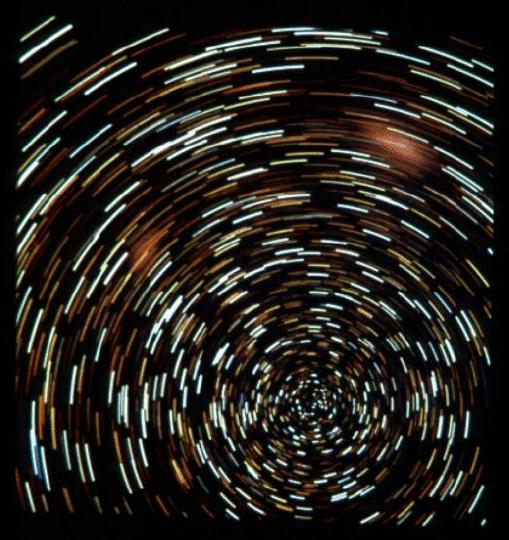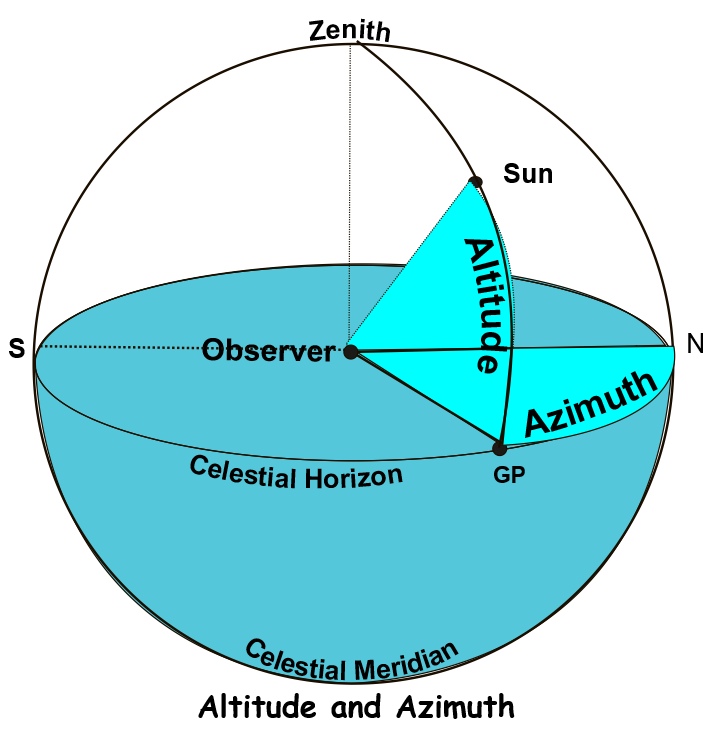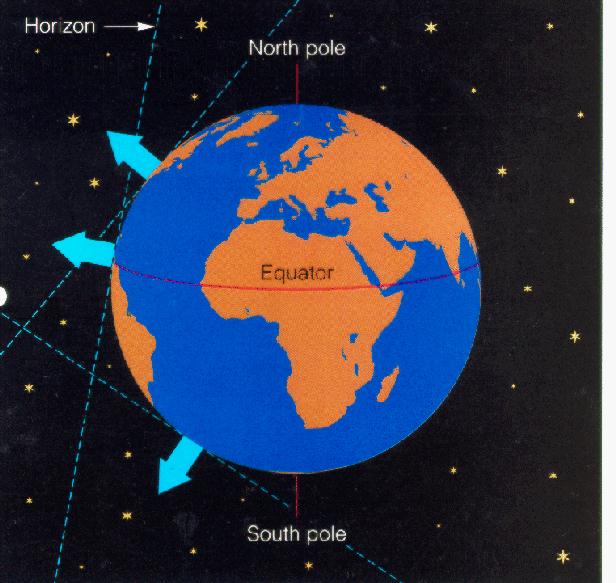

The stars appear to be fixed to the Celestial Sphere and since we are interested only in relative motion, we can imagine that the Earth is stationary and that the Celestial sphere is turning. The resultant motions are then rather simple. Because the stars do not move on the Celestial Sphere, they maintain constant distances from the rotation axis and so simply trace circles on the sky centered on the projection of the axis of rotation of the Earth onto the Celestial Sphere (that is, the North or South Celestial Pole).

The daily motions of all celestial objects (the stars, the Sun, the Moon, and the planets) follow this pattern. Note that the objects move from east-to-west across the sky which means that the Earth spins from west-to-east on its axis. Or, as viewed from the NCP, the Earth rotates in the CCW-sense.
To answer this question, we devise another way to locate objects on the sky.
We set-up a system that is defined for every observer on the Earth, we
set up what is known as
the Horizon System.
In the horizon system we see only
objects that are above the ground; we cannot see through
the Earth.
The line above which we can see the sky is known as the
Horizon.

The point directly above the head of the observer is referred to as the zenith. The opposite point directly below the feet of the observer is referred to as the nadir. The circle that passes through the North Celestial Pole, the zenith, the South Celestial Pole, and the nadir is referred to as the Celestial Meridian. The Celestial Meridian passes through the north and south points on the horizon, in fact, defining the north and south directions. The Celestial Sphere divides the sky into two halves, the east half and the west half. The Celestial Meridian marks the halfway point and the maximum altitude reached by celestial objects as they make their daily treks across the sky.
We define coordinates in the Horizon System as follows:

The location of the zenith and horizon on the Celestial Sphere for an observer changes quite dramatically as one moves (in latitude) on the Earth. It was this type of observation that was one of pieces of evidence that led the Greeks to conclude that the Earth was spherical in shape.
|
 |
North Pole (latitude=90 degrees):
consequently, all diurnal circles are parallel to the horizon. All visible stars don't rise or set; all stars are circumpolar. For a given latitude,
|

|
Equator (latitude=0 degrees):
|

|
Intermediate Latitudes
|

|
Today, Polaris, the North Star, sits right near the NCP. There is no comparable star near the SCP in the southern hemisphere.
The sidereal day is 23 h 56 m 4.091 s. The sidereal day is defined as the time it takes a star to make a complete trip around the sky. The Solar day is defined as the time it takes the Sun to make two successive crossings of the Celestial Meridian:

If the Earth were stationary, then the Solar Day and the Sidereal Day would be precisely the same. However, we know that the Earth also revolves about the Sun. How does this affect the Solar Day?

Because the Earth roughly moves at a rate of (360 degrees)/(365.25 days) ~ 1 degree per day, the Earth will have moved 1 degree after 1 day. This means that in order for Sun to return to the Celestial Meridian, the Earth must turn roughly 1 more degree. That is, the Earth must turn ~1/360-th of the way around again to have the Sun reappear on the Celestial Meridian. This means that the Solar Day will be roughly 1/360-th times longer than the Sidereal Day.
If the Earth's orbital motion were steady with respect to the Celestial Equator, then this would be the entire story. Unfortunately, the Earth's orbital speed is not constant; it varies throughtout the course of the year because of the elliptical shape of its orbit and the mis-alignment of the ecliptic and the Celestial Equator. Consequently, the length of the Solar Day also varies throughout the course of the year. From a timekeeping standpoint, this is not acceptable and so the Mean Solar Day was defined to be the basis for timekeeping. The Mean Solar Day is the average length of the true Solar Day. The Mean Solar Day defines the clock day.
This is why the Sun sometimes appears to be late and sometimes appears to be early with respect to clock time. By early and late, I mean that the Sun does not cross the Meridian at the same time every day! This information is carried in the analemma (note the diurnal circles of Sun).
